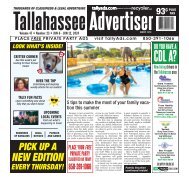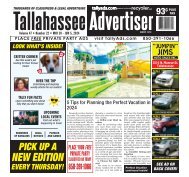You also want an ePaper? Increase the reach of your titles
YUMPU automatically turns print PDFs into web optimized ePapers that Google loves.
gle” versions that were tested back in the ’90s. They’ve come a<br />
long way, providing more traction and longer life expectancy than<br />
their predecessors. Wide-base tires save weight — and therefore,<br />
fuel — and because of this, they are popular choices. A potential<br />
downside is that when one goes flat, there isn’t another tire next to<br />
it to absorb the load. A flat tire will put your truck on the side of the<br />
road until help arrives.<br />
It’s the driver’s responsibility to make sure the truck’s tires are<br />
inspected regularly, and that includes air pressure in the tire. A<br />
whack with a “tire thumper,” a hammer or even a flat hand can<br />
indicate that a tire is flat or dangerously low on air, but only an airpressure<br />
gauge can detect smaller discrepancies.<br />
In some cases, an inflation pressure that is only a few PSI<br />
(pound per square inch) off can cause damage. In the case of steer<br />
tires, differing air pressures can cause the truck to pull to one side<br />
or the other. In cases where tandem tires are used, low air pressure<br />
in one tire can cause the tire beside it to absorb more of the<br />
weight that should be split evenly between them, increasing heat<br />
buildup and possibly overloading the tire. In any case, too little or<br />
too much air pressure can cause uneven tread wear, reducing the<br />
tire’s useful life.<br />
Every driver should carry a tire gauge. In addition, a handy device<br />
to have on hand is an air hose that will connect to the tractor’s<br />
emergency brake like. By pushing in the tractor protection valve,<br />
leaving the red trailer valve engaged, the air line is charged with<br />
enough pressure to air up a truck tire. Without an air hose, the<br />
driver must hope the truck makes it to the nearest truck stop and<br />
that there is an accessible air hose to use.<br />
Tires should be thoroughly inspected, including both the sides<br />
and the tread, during every pre or post-trip inspection. Foreign objects<br />
lodged in the tread can work their way through steel belts<br />
and into the tire’s air chamber, causing problems later. Often, objects<br />
such as screws and nails can be pulled out of the tread before<br />
they break through. Even when objects penetrate deeply enough to<br />
cause an air leak, the sooner they are removed the better. The longer<br />
they remain, the more damage they can do, potentially creating<br />
holes that are too large to repair.<br />
Holes, cuts and tears in tire sidewalls can’t be repaired, so it’s<br />
very important to inspect them regularly. Even on the brightest<br />
day, a flashlight may be necessary to get a good look between tandem<br />
tires or to view the inward side of tires. If damage is found,<br />
the tire must be replaced. Bulges or bubbles in the sidewall indicate<br />
a problem with an inner layer of the tire, allowing air to push<br />
out the sidewall. These should be looked at quickly. These bulges<br />
will only get worse if left alone — and they will eventually result<br />
in a blowout.<br />
Additional, quick inspections should be done whenever the<br />
truck is stopped. Checking each tire’s air pressure more than once<br />
a day is not necessary unless a problem is detected. A walkaround<br />
and visual inspection, however, can help identify recent damage<br />
and prevent a bigger problem later. Some drivers make a habit<br />
of walking down one side of their truck on the way to the truck<br />
stop’s restaurant or restroom and then checking the other side on<br />
the walk back.<br />
Tires are one of the most abused items on a truck. Take care of<br />
yours — and they’ll take care of you.<br />
The Trucker Media Group is<br />
looking for a multi-media<br />
advertising sales executive.<br />
✔Full✔time,✔competitive✔<br />
✔<br />
salary✔and✔benefits<br />
✔Remote✔position<br />
✔<br />
✔Minimal✔travel<br />
✔<br />
✔Digital✔and✔print✔ad✔sales<br />
✔<br />
For a full job description,<br />
email your resume to: ✔<br />
MegL@TheTruckerMediaGroup.com<br />
WWW.THETRUCKERJOBS.COM THE TRUCKER JOBS MAGAZINE | NOVEMBER 2022 19

















